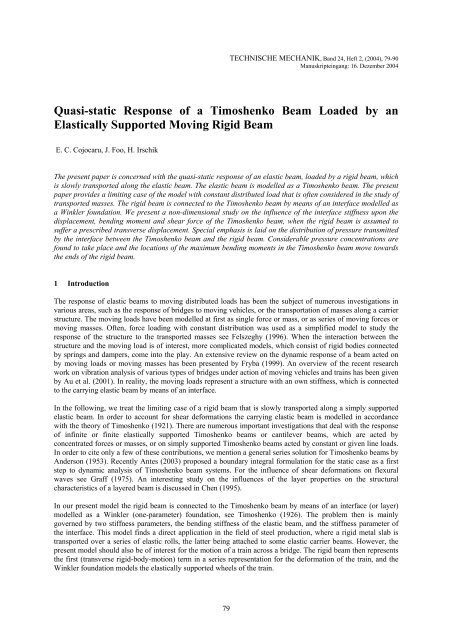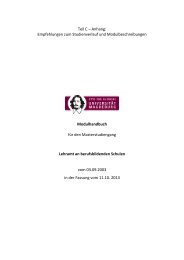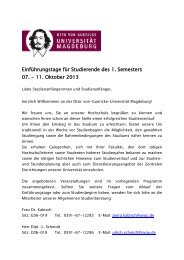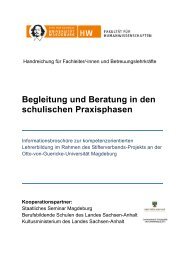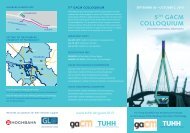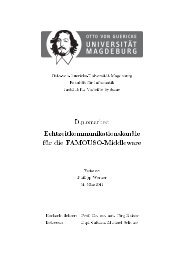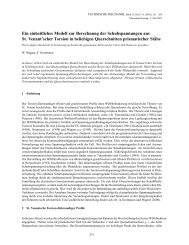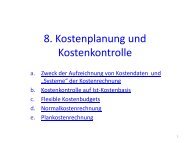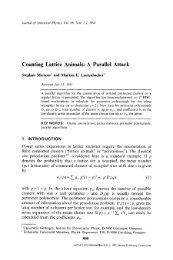Quasi-static Response of a Timoshenko Beam Loaded by an ...
Quasi-static Response of a Timoshenko Beam Loaded by an ...
Quasi-static Response of a Timoshenko Beam Loaded by an ...
You also want an ePaper? Increase the reach of your titles
YUMPU automatically turns print PDFs into web optimized ePapers that Google loves.
TECHNISCHE MECHANIK, B<strong>an</strong>d 24, Heft 2, (2004), 79-90<br />
M<strong>an</strong>uskripteing<strong>an</strong>g: 16. Dezember 2004<br />
<strong>Quasi</strong>-<strong>static</strong> <strong>Response</strong> <strong>of</strong> a <strong>Timoshenko</strong> <strong>Beam</strong> <strong>Loaded</strong> <strong>by</strong> <strong>an</strong><br />
Elastically Supported Moving Rigid <strong>Beam</strong><br />
E. C. Cojocaru, J. Foo, H. Irschik<br />
The present paper is concerned with the quasi-<strong>static</strong> response <strong>of</strong> <strong>an</strong> elastic beam, loaded <strong>by</strong> a rigid beam, which<br />
is slowly tr<strong>an</strong>sported along the elastic beam. The elastic beam is modelled as a <strong>Timoshenko</strong> beam. The present<br />
paper provides a limiting case <strong>of</strong> the model with const<strong>an</strong>t distributed load that is <strong>of</strong>ten considered in the study <strong>of</strong><br />
tr<strong>an</strong>sported masses. The rigid beam is connected to the <strong>Timoshenko</strong> beam <strong>by</strong> me<strong>an</strong>s <strong>of</strong> <strong>an</strong> interface modelled as<br />
a Winkler foundation. We present a non-dimensional study on the influence <strong>of</strong> the interface stiffness upon the<br />
displacement, bending moment <strong>an</strong>d shear force <strong>of</strong> the <strong>Timoshenko</strong> beam, when the rigid beam is assumed to<br />
suffer a prescribed tr<strong>an</strong>sverse displacement. Special emphasis is laid on the distribution <strong>of</strong> pressure tr<strong>an</strong>smitted<br />
<strong>by</strong> the interface between the <strong>Timoshenko</strong> beam <strong>an</strong>d the rigid beam. Considerable pressure concentrations are<br />
found to take place <strong>an</strong>d the locations <strong>of</strong> the maximum bending moments in the <strong>Timoshenko</strong> beam move towards<br />
the ends <strong>of</strong> the rigid beam.<br />
1 Introduction<br />
The response <strong>of</strong> elastic beams to moving distributed loads has been the subject <strong>of</strong> numerous investigations in<br />
various areas, such as the response <strong>of</strong> bridges to moving vehicles, or the tr<strong>an</strong>sportation <strong>of</strong> masses along a carrier<br />
structure. The moving loads have been modelled at first as single force or mass, or as series <strong>of</strong> moving forces or<br />
moving masses. Often, force loading with const<strong>an</strong>t distribution was used as a simplified model to study the<br />
response <strong>of</strong> the structure to the tr<strong>an</strong>sported masses see Felszeghy (1996). When the interaction between the<br />
structure <strong>an</strong>d the moving load is <strong>of</strong> interest, more complicated models, which consist <strong>of</strong> rigid bodies connected<br />
<strong>by</strong> springs <strong>an</strong>d dampers, come into the play. An extensive review on the dynamic response <strong>of</strong> a beam acted on<br />
<strong>by</strong> moving loads or moving masses has been presented <strong>by</strong> Fryba (1999). An overview <strong>of</strong> the recent research<br />
work on vibration <strong>an</strong>alysis <strong>of</strong> various types <strong>of</strong> bridges under action <strong>of</strong> moving vehicles <strong>an</strong>d trains has been given<br />
<strong>by</strong> Au et al. (2001). In reality, the moving loads represent a structure with <strong>an</strong> own stiffness, which is connected<br />
to the carrying elastic beam <strong>by</strong> me<strong>an</strong>s <strong>of</strong> <strong>an</strong> interface.<br />
In the following, we treat the limiting case <strong>of</strong> a rigid beam that is slowly tr<strong>an</strong>sported along a simply supported<br />
elastic beam. In order to account for shear deformations the carrying elastic beam is modelled in accord<strong>an</strong>ce<br />
with the theory <strong>of</strong> <strong>Timoshenko</strong> (1921). There are numerous import<strong>an</strong>t investigations that deal with the response<br />
<strong>of</strong> infinite or finite elastically supported <strong>Timoshenko</strong> beams or c<strong>an</strong>tilever beams, which are acted <strong>by</strong><br />
concentrated forces or masses, or on simply supported <strong>Timoshenko</strong> beams acted <strong>by</strong> const<strong>an</strong>t or given line loads.<br />
In order to cite only a few <strong>of</strong> these contributions, we mention a general series solution for <strong>Timoshenko</strong> beams <strong>by</strong><br />
Anderson (1953). Recently Antes (2003) proposed a boundary integral formulation for the <strong>static</strong> case as a first<br />
step to dynamic <strong>an</strong>alysis <strong>of</strong> <strong>Timoshenko</strong> beam systems. For the influence <strong>of</strong> shear deformations on flexural<br />
waves see Graff (1975). An interesting study on the influences <strong>of</strong> the layer properties on the structural<br />
characteristics <strong>of</strong> a layered beam is discussed in Chen (1995).<br />
In our present model the rigid beam is connected to the <strong>Timoshenko</strong> beam <strong>by</strong> me<strong>an</strong>s <strong>of</strong> <strong>an</strong> interface (or layer)<br />
modelled as a Winkler (one-parameter) foundation, see <strong>Timoshenko</strong> (1926). The problem then is mainly<br />
governed <strong>by</strong> two stiffness parameters, the bending stiffness <strong>of</strong> the elastic beam, <strong>an</strong>d the stiffness parameter <strong>of</strong><br />
the interface. This model finds a direct application in the field <strong>of</strong> steel production, where a rigid metal slab is<br />
tr<strong>an</strong>sported over a series <strong>of</strong> elastic rolls, the latter being attached to some elastic carrier beams. However, the<br />
present model should also be <strong>of</strong> interest for the motion <strong>of</strong> a train across a bridge. The rigid beam then represents<br />
the first (tr<strong>an</strong>sverse rigid-body-motion) term in a series representation for the deformation <strong>of</strong> the train, <strong>an</strong>d the<br />
Winkler foundation models the elastically supported wheels <strong>of</strong> the train.<br />
79
The following study deals with the case <strong>of</strong> a quasi-<strong>static</strong> motion <strong>of</strong> the rigid beam. In the case <strong>of</strong> a fast motion,<br />
vibrations about the corresponding quasi-<strong>static</strong> response <strong>of</strong> the <strong>Timoshenko</strong> beam will take place. The latter<br />
dynamic response is intended to be treated in a future investigation. Here, we are interested in the following<br />
interesting phenomenon, which has been detected in our subsequent computations: When the rigid beam is<br />
assumed to obey a given tr<strong>an</strong>sverse displacement, such that the interface is compressed, <strong>an</strong>d when the bending<br />
stiffness <strong>of</strong> the <strong>Timoshenko</strong> beam is sufficiently small, then displacements, bending moments <strong>an</strong>d shear forces<br />
are found to deviate strongly from their well-known distributions for the case <strong>of</strong> a line load with const<strong>an</strong>t<br />
distribution. In contrast to the latter solutions, considerable pressure concentrations are seen to occur at the ends<br />
<strong>of</strong> the region covered <strong>by</strong> the rigid beam, <strong>an</strong>d the locations <strong>of</strong> the maximum bending moments in the <strong>Timoshenko</strong><br />
beam move towards the ends <strong>of</strong> this region. Moreover, when the stiffness <strong>of</strong> the <strong>Timoshenko</strong> beam is further<br />
decreased, the Winkler interface even must suffer tensile forces, or a lift-<strong>of</strong>f is to be expected in some regions <strong>of</strong><br />
the interface.<br />
In the following, this situation is described in a non-dimensional setting in order to cover all possible cases <strong>by</strong> a<br />
single formulation. Accordingly, the problem is formulated in the form <strong>of</strong> two sets <strong>of</strong> first-order ordinary<br />
differential equations, one set being valid for the unloaded part <strong>of</strong> the <strong>Timoshenko</strong> beam, the other for the region<br />
loaded <strong>by</strong> the rigid beam. The two sets are coupled <strong>by</strong> me<strong>an</strong>s <strong>of</strong> tr<strong>an</strong>sition conditions valid at the location <strong>of</strong> the<br />
front <strong>of</strong> the rigid beam. The problem is solved for various locations <strong>of</strong> this front along the elastic beam, where<br />
we assume the rigid beam is long enough, such that only one front is to be considered. When the elastic beam<br />
would be modelled in the framework <strong>of</strong> the Bernoulli-Euler theory <strong>of</strong> beams, the non-dimensionalised problem<br />
were governed <strong>by</strong> a single similarity complex or Pi-number only, namely a non-dimensional interface stiffness<br />
formed <strong>by</strong> the ratio <strong>of</strong> the Winkler foundation stiffness <strong>an</strong>d the bending stiffness <strong>of</strong> the elastic beam, as well as<br />
<strong>by</strong> the fourth power <strong>of</strong> the sp<strong>an</strong> <strong>of</strong> the elastic beam. For the notion <strong>of</strong> a Pi number in similarity methods <strong>of</strong><br />
engineering dynamics, see e.g. Baker et al. (1991). In the present paper, we also take into account the influence<br />
<strong>of</strong> shear stiffness <strong>of</strong> the elastic beam according to the theory <strong>of</strong> <strong>Timoshenko</strong> (1921), such that a second Pi<br />
number comes into the play. Since the influence <strong>of</strong> the latter is small, it was kept fixed in all <strong>of</strong> the numerical<br />
computations.<br />
In order to derive <strong>an</strong>d demonstrate the above cited effect <strong>of</strong> pressure concentration, we utilise the symbolic<br />
computer code Maple 7 for solving the fourth-order system <strong>of</strong> ordinary differential equations with sp<strong>an</strong>-wise<br />
const<strong>an</strong>t coefficients, where we use methods <strong>of</strong> linear algebra, as described lucidly e.g. in the book <strong>of</strong><br />
Luenberger (1979). The results <strong>of</strong> our study are presented graphically in a non-dimensional form as a function <strong>of</strong><br />
the axial co-ordinate <strong>of</strong> the elastic beam for various values <strong>of</strong> the non-dimensional interface stiffness, <strong>an</strong>d for<br />
three locations <strong>of</strong> the front <strong>of</strong> the rigid beam. Non-dimensional deflection, bending moments <strong>an</strong>d shear forces<br />
are depicted, <strong>an</strong>d special emphasis is laid on the pressure distribution between the elastic beam <strong>an</strong>d the rigid<br />
beam. In order to prove the results <strong>of</strong> our symbolic computations we also developed a Finite Element model<br />
using the powerful code ABAQUS 6.2. The convergence behaviour <strong>of</strong> the Finite Element model turned out to<br />
depend on the type <strong>of</strong> modelling <strong>of</strong> the Winkler interface <strong>by</strong> discrete springs, however the results were almost<br />
identical to the results <strong>of</strong> the symbolic computation in all <strong>of</strong> the considered cases.<br />
2 Rigid <strong>Beam</strong> on a Winkler Foundation Travelling on a Simply Supported <strong>Beam</strong><br />
Consider a simply supported straight beam <strong>of</strong> length L that represents the elastic beam in our model. A subscript<br />
(b) is used to denote the corresponding mech<strong>an</strong>ical entities see Figure 1a. We utilise the theory <strong>of</strong> <strong>Timoshenko</strong><br />
(1921) to describe the deformation <strong>of</strong> the elastic beam. In the following, B b<br />
=E b<br />
I b<br />
denotes the effective bending<br />
stiffness, E b<br />
is the Young's modulus, I b<br />
is the second moment <strong>of</strong> inertia <strong>of</strong> the cross-sectional area. The shear<br />
stiffness is given <strong>by</strong> S b<br />
=γA b<br />
G b<br />
, where γ is the <strong>Timoshenko</strong> shear coefficient, A b<br />
is the cross-sectional area <strong>an</strong>d<br />
G b<br />
denotes the shear modulus <strong>of</strong> the <strong>Timoshenko</strong> beam. This elastic beam is loaded <strong>by</strong> tr<strong>an</strong>sverse forces q b<br />
.<br />
Deflection, slope, bending moment <strong>an</strong>d shear force <strong>of</strong> the beam are denoted <strong>by</strong> w b<br />
, ϕ b<br />
, M b<br />
<strong>an</strong>d Q b<br />
, respectively.<br />
In our problem, the tr<strong>an</strong>sverse forces q b<br />
represents the pressure that is tr<strong>an</strong>smitted <strong>by</strong> <strong>an</strong> elastic interface from<br />
the moving rigid beam to the elastic beam see Figure 1b. The rigid beam is assumed to move slowly across the<br />
elastic beam, <strong>an</strong>d to be displaced in tr<strong>an</strong>sverse direction downwards to the <strong>Timoshenko</strong> beam. In order to fix<br />
ideas, the subscript (t) is used to denote the tr<strong>an</strong>sverse displacement <strong>of</strong> the rigid beam, w t<br />
see Figure 1. For the<br />
sake <strong>of</strong> brevity, <strong>an</strong>d in order to avoid ambiguities between the two beams under consideration, we call the<br />
<strong>Timoshenko</strong> beam the “bridge” in the following. That is why we have introduced the index b for the<br />
80
<strong>Timoshenko</strong> beam. We model the tr<strong>an</strong>smitting interface <strong>by</strong> a Winkler foundation with stiffness parameter kt,<br />
such that:<br />
q b =−k t ( w b − w t ), (1)<br />
see <strong>Timoshenko</strong> (1926) <strong>an</strong>d Knothe (2001). All <strong>of</strong> the mech<strong>an</strong>ical entities under consideration are described as a<br />
function <strong>of</strong> the axial co-ordinate x measured in <strong>an</strong> inertial frame which has the origin at the left end <strong>of</strong> the<br />
bridge, see Figure 1a. The rigid beam is assumed to be semi-infinite <strong>an</strong>d to travel slowly along the bridge, such<br />
that the front <strong>of</strong> the rigid beam is located at the dist<strong>an</strong>ce s(t), also measured from the left end <strong>of</strong> the beam, see<br />
Figure 1a.<br />
a) b)<br />
rigid beam<br />
w t (t)<br />
rigid beam<br />
k t<br />
q b =-k t (w b -w t ) M 0<br />
0<br />
s(t)<br />
x<br />
Q 0 Q 0<br />
elastic beam, B b , S b<br />
L<br />
s(t) L-s(t)<br />
Figure 1. An elastic beam carrying a rigid elastically supported beam<br />
In the co-ordinate system under consideration, the problem c<strong>an</strong> be described <strong>by</strong> the following two boundary<br />
value problems <strong>of</strong> fourth order:<br />
0 < x ≤ s(t) :<br />
dw b<br />
l<br />
dx<br />
= ϕ l<br />
b<br />
+ Q l<br />
b<br />
,<br />
S b<br />
dϕ b<br />
l<br />
dx<br />
l<br />
=−M b<br />
,<br />
B b<br />
dM b<br />
l<br />
dx<br />
= Q l b ,<br />
dQ b<br />
l<br />
dx = k t (w b<br />
l<br />
− w t ),<br />
x = 0: w b<br />
l<br />
x = s(t) l<br />
= 0, M b<br />
l<br />
= 0,<br />
l<br />
l<br />
: M b = M 0 , Q b<br />
= Q 0 .<br />
(2)<br />
s(t) < x ≤ L :<br />
dw b<br />
r<br />
dx<br />
= ϕ r b + Q r<br />
b<br />
,<br />
S b<br />
dϕ b<br />
r<br />
dx<br />
r<br />
=−M b<br />
,<br />
B b<br />
dM b<br />
r<br />
dx<br />
= Q r b ,<br />
dQ b<br />
r<br />
dx = 0,<br />
x = s(t) r : M b r = M 0 , Q b r = Q 0 ,<br />
(3)<br />
x = L : w b r = 0, M b r = 0 .<br />
For details <strong>of</strong> the underlying beam theory, see <strong>Timoshenko</strong> (1921), Graff (1975) <strong>an</strong>d Ziegler (1991). In<br />
equations (2) <strong>an</strong>d (3), the superscripts l <strong>an</strong>d r denote the regions on the left <strong>an</strong>d right h<strong>an</strong>d side <strong>of</strong> the front <strong>of</strong> the<br />
rigid beam, x=s(t). Bending moment <strong>an</strong>d shear force in the bridge at this location is denoted as M 0 <strong>an</strong>d Q 0 ,<br />
respectively. Since we are interested in a quasi-<strong>static</strong> solution, the influence <strong>of</strong> the velocity <strong>of</strong> the rigid beam,<br />
<strong>an</strong>d thus <strong>an</strong>y effect <strong>of</strong> inertia, has been neglected in equations (2) <strong>an</strong>d (3). This allows to model the problem as a<br />
system <strong>of</strong> first-order ordinary differential equations.<br />
According to the force method, see Ziegler (1991), the additional unknowns M 0 <strong>an</strong>d Q 0 are calculated from the<br />
following two conditions <strong>of</strong> kinematical continuity for the bridge at the location s(t):<br />
w b l (x = s(t) l ) = w b r (x = s(t) r ), ϕ b l (x = s(t) l ) = ϕ b r (x = s(t) r ). (4)<br />
In order to work with the minimum number <strong>of</strong> parameters that determine the solution <strong>of</strong> the problem in h<strong>an</strong>d, we<br />
introduce the following dimensionless formulations:<br />
x = L ) x , s = L s ) , w t = h w )<br />
t , w l,r b = h w ) l,r b , ϕ l,r b = h )<br />
ϕ l,r l<br />
L b , M ,r b = B b h )<br />
M l,r<br />
L 2 b , Q l,r b = B b h )<br />
Q l,r<br />
L 3 b , (5)<br />
81
where a superimposed hat is used to denote dimensionless entities, x is the axial co-ordinate, s is the length <strong>of</strong><br />
the rigid beam, w t is the displacement <strong>of</strong> the rigid beam, w b l,r , ϕ b l,r , M b l,r <strong>an</strong>d Q b l,r are respective the deflection,<br />
slope, bending moment <strong>an</strong>d shear force in the bridge on the left respective right side <strong>of</strong> the front <strong>of</strong> the rigid<br />
beam. It was preferable to scale the deflection <strong>of</strong> the bridge <strong>an</strong>d the displacement <strong>of</strong> the rigid beam <strong>by</strong> me<strong>an</strong>s <strong>of</strong><br />
a characteristic thickness h. The problem now is seen to be governed <strong>by</strong> non-dimensional interface stiffness in<br />
the form:<br />
)<br />
k = k t<br />
B b<br />
L 4 . (6)<br />
The non-dimensional pressure distribution between bridge <strong>an</strong>d the rigid beam becomes:<br />
)<br />
q b =− k )<br />
( w )<br />
b − w )<br />
t ) . (7)<br />
We also introduce the following non-dimensional parameter characterising the influence <strong>of</strong> shear:<br />
α =<br />
B b<br />
S b<br />
L 2 . (8)<br />
We are now ready to write the differential equations given in equations (2) <strong>an</strong>d (3) in dimensionless matrix form<br />
as:<br />
0 < ) x ≤ ) s :<br />
)<br />
s < ) x ≤ L )<br />
:<br />
⎡<br />
)<br />
⎢ )<br />
d<br />
d ) ⎢<br />
)<br />
x ⎢<br />
)<br />
⎣ ⎢<br />
w b<br />
l<br />
ϕ b<br />
l<br />
M b<br />
l<br />
Q b<br />
l<br />
⎡ )<br />
⎢ )<br />
d<br />
d ) ⎢<br />
)<br />
x ⎢<br />
)<br />
⎣ ⎢<br />
w b<br />
r<br />
ϕ b<br />
r<br />
M b<br />
r<br />
Q b<br />
r<br />
⎤ ⎡ 0 1 0 α⎤<br />
⎡<br />
)<br />
⎥ ⎢<br />
⎥ ⎢ )<br />
⎥ 0 0 −1 0<br />
= ⎢<br />
⎥ ⎢<br />
)<br />
⎥ ⎢ 0 0 0 1⎥<br />
⎢<br />
⎢ ) ⎥<br />
)<br />
⎦ ⎥ ⎣ k 0 0 0⎦<br />
⎣ ⎢<br />
w b<br />
l<br />
ϕ b<br />
l<br />
M b<br />
l<br />
Q b<br />
l<br />
⎤ ⎡ 0 ⎤<br />
⎥ ⎢ ⎥<br />
⎥ 0<br />
+ ⎢ ⎥<br />
, (9)<br />
⎥ ⎢ 0<br />
⎢<br />
⎦ ⎥ − k )<br />
⎣ w )<br />
⎥<br />
⎥<br />
t ⎦<br />
⎤ ⎡ 0 1 0 α⎤<br />
⎡ ) r<br />
w b<br />
⎤<br />
⎥ ⎢<br />
⎥ ⎢<br />
⎥ 0 0 −1 0<br />
) r<br />
⎥<br />
= ⎢<br />
⎥ ⎢ ϕ<br />
) b ⎥ . (10)<br />
⎥ ⎢ 0 0 0 1⎥<br />
⎢ r<br />
M b<br />
⎥<br />
⎢<br />
⎥<br />
)<br />
r<br />
⎦ ⎥ ⎣ 0 0 0 0⎦<br />
⎣ ⎢ Q b ⎦ ⎥<br />
This system <strong>of</strong> first-order differential equations with const<strong>an</strong>t coefficients has to be solved considering the nondimensional<br />
form <strong>of</strong> the boundary conditions given in equations (2) <strong>an</strong>d (3):<br />
)<br />
x = 0: w ) l<br />
b<br />
= 0, M ) l<br />
b<br />
= 0,<br />
)<br />
x = ) s l (t): M ) l<br />
b<br />
= M )<br />
0<br />
, Q ) l<br />
b<br />
= )<br />
Q 0<br />
,<br />
(11)<br />
where<br />
)<br />
x = ) s r (t) : M ) r b<br />
= M )<br />
0<br />
, Q ) r b<br />
= Q )<br />
0<br />
,<br />
)<br />
x = L )<br />
: w ) r b<br />
= 0, M ) r b<br />
= 0,<br />
)<br />
M 0 <strong>an</strong>d Q )<br />
0 are the non-dimensional forms <strong>of</strong> M 0 <strong>an</strong>d Q 0 :<br />
(12)<br />
)<br />
M 0 = L2<br />
B b<br />
h M 0 ,<br />
)<br />
Q 0 = L3<br />
B b<br />
h Q 0 . (13)<br />
The non-dimensional form <strong>of</strong> the continuity conditions from equations (4) reads:<br />
)<br />
w l b ( ) x = s ) ( t ) ) l ) = w ) r b ( x ) = s ) ( ) t ) r ),<br />
)<br />
ϕ b l ( ) x = ) s ( ) t ) l ) = ) ϕ b r ( ) x = ) s ( ) t ) r ). (14)<br />
82
3 Solution <strong>by</strong> me<strong>an</strong>s <strong>of</strong> Symbolic Computation<br />
The boundary value problems presented in Section 2 were solved <strong>by</strong> me<strong>an</strong>s <strong>of</strong> the symbolic computer code<br />
Maple 7. For the left region <strong>of</strong> the bridge, loaded <strong>by</strong> the rigid beam, we solved the system <strong>of</strong> first-order<br />
differential equations (9) in terms <strong>of</strong> the boundary conditions (11) <strong>an</strong>d the loads. The system <strong>of</strong> differential<br />
equations c<strong>an</strong> be formally written as:<br />
X ′ = AX + bu , (15)<br />
where X denotes a state vector,<br />
l<br />
[ Q b ],<br />
X T = w ) l )<br />
b ϕ l )<br />
b M l )<br />
b<br />
X ′ T = d d x<br />
)<br />
w ) ) )<br />
l l<br />
[ Q b b ] , (16)<br />
A is the 4×4 matrix <strong>of</strong> coefficients:<br />
⎡ 0 1 0 α⎤<br />
⎢<br />
⎥<br />
0 0 −1 0<br />
A = ⎢<br />
⎥ , (17)<br />
⎢ 0 0 0 1⎥<br />
⎢ ) ⎥<br />
⎣ k 0 0 0⎦<br />
<strong>an</strong>d b is the vector <strong>of</strong> external loads:<br />
[ ] ,<br />
b T = 0 0 0 −1<br />
u = k )<br />
w )<br />
t<br />
.<br />
(18)<br />
Following Luenberger, the general solution <strong>of</strong> the system (15) is:<br />
)<br />
x<br />
∫ (19)<br />
X( x ) ) =Φ( ) x )X(0)+ Φ( ) x − τ ) b u(τ )dτ<br />
0<br />
where τ is <strong>an</strong> independent variable. The first term on the right-h<strong>an</strong>d side <strong>of</strong> equation (19) represents the response<br />
due to the state vector X(0). For systems with const<strong>an</strong>t coefficients, the state-tr<strong>an</strong>sition matrix is known to be <strong>of</strong><br />
the form Φ( x ) ) = exp(A x ) ) , see Luenberger (1979). In order to compute the state-tr<strong>an</strong>sition matrix, the Laplace<br />
tr<strong>an</strong>sform method was utilised:<br />
) -1<br />
−1<br />
Φ ( x ) = L (( pI<br />
− A ) ).<br />
(20)<br />
I denotes the identity matrix, <strong>an</strong>d p st<strong>an</strong>ds for the parameter <strong>of</strong> the Laplace tr<strong>an</strong>sformation. We used Laplace<br />
tr<strong>an</strong>sformation approach, since the direct computation <strong>of</strong> Φ( x ) ) <strong>by</strong> the comm<strong>an</strong>d exponential <strong>of</strong> Maple 7 failed in<br />
our h<strong>an</strong>ds. We have been told that the corresponding computational problem will be corrected in future versions<br />
<strong>of</strong> Maple.<br />
Because the vector X(0) is not entirely known, we used the boundary conditions (11) to compute the unknown<br />
terms in X(0) as well as in X( ) s ) . For that sake, equation (19) is written for ) x = ) s :<br />
)<br />
s<br />
∫ . (21)<br />
X( ) s ) =Φ( ) s )X(0) + Φ( ) s − τ) b u(τ)dτ<br />
0<br />
83
The relation (21) reads in <strong>an</strong> ample form:<br />
⎡ )<br />
⎢ )<br />
⎢<br />
⎢<br />
)<br />
⎢ )<br />
⎣ ⎢<br />
w b<br />
l<br />
ϕ b<br />
l<br />
⎤<br />
⎥<br />
⎥<br />
⎥<br />
M 0<br />
⎥<br />
Q 0 ⎦ ⎥ )<br />
x = ) s<br />
⎡ 0 ⎤<br />
=Φ( s ) ⎢ ) l<br />
ϕ<br />
⎥<br />
) ⎢ b ⎥<br />
⎢ 0 ⎥<br />
⎢ )<br />
l<br />
⎣ Q b ⎦<br />
⎥<br />
)<br />
x = 0<br />
In the system (22), the unknowns are:<br />
)<br />
ϕ b l (0),<br />
)<br />
s<br />
+ ∫ Φ( ) s −τ ) b u(τ )dτ , (22)<br />
0<br />
)<br />
Q b l (0), ) w b l ( ) s ), ϕ b l ( ) s ) . (23)<br />
We have thus arrived at a system <strong>of</strong> four linear equations, the solution <strong>of</strong> which defines the vectors X(0) <strong>an</strong>d<br />
X( ) s ) in equation (21), expressed as functions <strong>of</strong> M )<br />
0 <strong>an</strong>d Q )<br />
0 .<br />
To solve the above problem, we used the functions <strong>of</strong> two packages <strong>of</strong> the symbolic computer code Maple 7, see<br />
(2001): the inttr<strong>an</strong>s Package that is a collection <strong>of</strong> functions designed to compute integral tr<strong>an</strong>sforms, <strong>an</strong>d the<br />
Linear Algebra Package that allows st<strong>an</strong>dard matrix m<strong>an</strong>ipulation. We created the matrix A <strong>an</strong>d vectors X T , X ’T<br />
<strong>an</strong>d b T as a list <strong>of</strong> initial values, <strong>an</strong>d the matrix pI with help <strong>of</strong> the DiagonalMatrix function. With the<br />
MatrixInverse function we got the inverse <strong>of</strong> the (pI-A) matrix <strong>an</strong>d with invlaplace function the inverse Laplace<br />
tr<strong>an</strong>sform <strong>of</strong> (pI-A) -1 , that is the state-tr<strong>an</strong>sition matrix Φ( x ) ) . In order to apply the same procedure to each<br />
element <strong>of</strong> a matrix or vector we used the map function, specially dedicated for this type <strong>of</strong> operations. Also, to<br />
extract the exponential components from the expression <strong>of</strong> each term <strong>of</strong> the state-tr<strong>an</strong>sition matrix we used the<br />
op function. All the products between vectors <strong>an</strong>d scalars are defined with VectorScalarMultiply function, <strong>an</strong>d<br />
all the products between matrix <strong>an</strong>d vector with MatrixVectorMultiply function. In order to tr<strong>an</strong>sform the system<br />
(22) into a system <strong>of</strong> linear equations, we used the GenerateMatrix function with augmented option. In this way<br />
the free terms <strong>of</strong> each equation are returned as the last column <strong>of</strong> the result matrix. We solved the new system <strong>of</strong><br />
equations for the set <strong>of</strong> unknowns (23) <strong>by</strong> the LinearSolve function. We substituted the result into the vector<br />
X(0) <strong>an</strong>d now we could compute the solution <strong>of</strong> equation (19) for <strong>an</strong>y ) x .<br />
In case <strong>of</strong> unloaded right h<strong>an</strong>d side <strong>of</strong> the bridge, the solution was performed through integration starting from<br />
the non-dimensional form <strong>of</strong> the boundary value problem (3). On the right side <strong>of</strong> the elastic beam the shear<br />
force is const<strong>an</strong>t <strong>an</strong>d equal to Q )<br />
0 . Then, the bending moment is:<br />
)<br />
M b r ( ) x ) =− )<br />
Q 0 ( )<br />
L − ) x ), (24)<br />
the slope becomes:<br />
)<br />
ϕ r b ( x ) ) = Q ) ⎛ )<br />
0 L x ) )<br />
x 2 ⎞<br />
−<br />
⎜ 2 ⎟ − C )<br />
, (25)<br />
⎝ ⎠<br />
<strong>an</strong>d the deflection is:<br />
)<br />
w r b ( ) x ) = ) ⎛<br />
⎜<br />
⎝<br />
(26)<br />
)<br />
Q 0 L<br />
)<br />
x 2<br />
2 − )<br />
x 3<br />
)<br />
6 − L 3 ⎞<br />
3 ⎟ − C ) ⎛<br />
⎜<br />
) x − L<br />
) ⎞<br />
⎟ + α Q ) ⎛ )<br />
⎝ ⎠ 0<br />
⎜ x − L<br />
) ⎞<br />
⎟ .<br />
⎝ ⎠<br />
⎠<br />
We substitute ) x = ) s into the equation (24) <strong>an</strong>d we obtain the bending moment at the front <strong>of</strong> the rigid beam:<br />
)<br />
M r b ( ) s ) =− Q )<br />
0 ( L )<br />
− s ) ) = M )<br />
0 , (27)<br />
which c<strong>an</strong> be substituted into equation (21). In this way the bridge is described <strong>by</strong> a set <strong>of</strong> functions which are<br />
dependent from two unknowns: Q )<br />
0 <strong>an</strong>d C )<br />
. We used the continuity conditions (14) in order to calculate these<br />
additional unknowns. The pressure between railway track <strong>an</strong>d rigid beam was computed according to the<br />
Winkler model (7) in a non-dimensional form.<br />
84
4 Solution <strong>by</strong> me<strong>an</strong>s <strong>of</strong> Finite Element Analysis<br />
In order to prove the results <strong>of</strong> the symbolic computation we developed a Finite Element model using the code<br />
ABAQUS 6.2. The model consists <strong>of</strong> a rigid beam, which is connected to a simply supported elastic beam <strong>by</strong><br />
me<strong>an</strong>s <strong>of</strong> single linear elastic springs. The single springs are attached to the adjacent nodes <strong>of</strong> the elastic <strong>an</strong>d the<br />
rigid beam elements. The element types used in our Finite Element model were: <strong>an</strong> B22 beam element that<br />
allows for tr<strong>an</strong>sverse shear deformation, a rigid body element, RB2D2 with tie nodes, which have tr<strong>an</strong>slational<br />
<strong>an</strong>d rotational degrees <strong>of</strong> freedom associated with the rigid beam. The motion <strong>of</strong> a single node, called the rigid<br />
body reference node governs the motion <strong>of</strong> the whole rigid beam. We kept the positions <strong>of</strong> the other nodes<br />
relative to the reference node const<strong>an</strong>t throughout a simulation. For the Winkler interface we took a linear spring<br />
element, SPRING2, which acts between two nodes in a fixed direction that is the vertical direction for our<br />
model.<br />
We assumed a BOX cross-section for the element B22. For the rigid body element RB2D2, we used the default<br />
unit cross-sectional area. For the element SPRING2 we studied the following three assumptions for the spring<br />
stiffness k FEM :<br />
k FEM = k t<br />
L<br />
N −1 , k L<br />
FEM = k t<br />
N , k FEM = k t<br />
L<br />
N + 1 , (28)<br />
where k t<br />
is the correspondent uniform distributed stiffness, L is the length <strong>of</strong> the elastic beam <strong>an</strong>d N is the finite<br />
elements number.<br />
For the elastic beam we used the material properties <strong>of</strong> isotropic steel, defined <strong>by</strong> the Young's modulus, E, <strong>an</strong>d<br />
the Poisson's ratio, ν, the shear modulus being given <strong>by</strong> G=E/2(1+ν).<br />
Thus, a linear <strong>static</strong> Finite Element <strong>an</strong>alysis was performed, where we prescribed boundary conditions for the<br />
bridge at both ends, <strong>an</strong>d for the rigid beam at the rigid body reference node. To verify the validity <strong>of</strong> the<br />
symbolic results we made the same <strong>an</strong>alysis with various numbers <strong>of</strong> elements <strong>an</strong>d studied the convergence <strong>of</strong><br />
the deflection <strong>an</strong>d bending moments.<br />
5 Numerical Results<br />
5.1 Symbolic Computation<br />
In order to illustrate the influence <strong>of</strong> the interface linear stiffness upon the pressure distribution between bridge<br />
<strong>an</strong>d train, we performed a series <strong>of</strong> symbolic computations as prescribed above. In all <strong>of</strong> these computations, the<br />
non-dimensional shear coefficient was set to α = 0.005091. This value e.g. corresponds to <strong>an</strong> bridge structure <strong>of</strong><br />
100 m sp<strong>an</strong>, consisting <strong>of</strong> a 7.5×7.5 m box-girder with I b<br />
= 74.65 m 4 , A b<br />
= 8.64 m 2 <strong>an</strong>d γ = 0.44. The material is<br />
steel with Young's modulus E b = 2.1×10 11 N/m 2 , shear modulus G b<br />
= 8.1×10 10 N/m 2 . With the above values one<br />
obtains B b<br />
= 1.5676×10 13 Nm 2 , S b<br />
= 3.0793×10 11 N. These values were also used in the Finite Element<br />
computations.<br />
We considered a unit non-dimensional rigid beam's displacement in vertical direction, w )<br />
t = 1, such that the train<br />
is displaced towards the bridge. We determined the dimensionless pressure distribution between rigid beam <strong>an</strong>d<br />
the bridge ) q b , the dimensionless deflection w )<br />
b , the dimensionless bending moment M )<br />
b <strong>an</strong>d the dimensionless<br />
shear-forces. These computations were performed for five values <strong>of</strong> the non-dimensional interface stiffness k )<br />
=<br />
100, 1000, 3000, 5000, 10000, <strong>an</strong>d for three locations <strong>of</strong> the front <strong>of</strong> the train, s ) (t) = 0.5 L )<br />
, 0.75 L )<br />
<strong>an</strong>d L )<br />
. The<br />
results are plotted in Figures 2-5. For some location <strong>of</strong> the train front, we furthermore determinate the nondimensional<br />
interface stiffness k )<br />
for which the minimum <strong>of</strong> the pressure distribution is zero, that me<strong>an</strong>s that the<br />
deflection <strong>of</strong> the bridge on the respective locations becomes equal to the train displacement, w )<br />
b = w )<br />
t = 1. The<br />
corresponding interface stiffness-values k )<br />
for zero ) q b are depicted in Figure 6 as a function <strong>of</strong> the front <strong>of</strong> the<br />
rigid beam, ) s (t) . For higher interface stiffness ratios, regions with tensile forces tr<strong>an</strong>smitted <strong>by</strong> the interface<br />
take place.<br />
85
)<br />
q b<br />
)<br />
s = 0.5 L<br />
)<br />
)<br />
k = 100<br />
)<br />
k = 1000<br />
)<br />
k = 1087<br />
)<br />
k = 3000<br />
)<br />
k = 5000<br />
)<br />
k = 10000<br />
)<br />
q b<br />
)<br />
)<br />
s = 0.75 L<br />
)<br />
)<br />
k = 100<br />
)<br />
k = 598<br />
)<br />
k = 1000<br />
)<br />
k = 3000<br />
)<br />
k = 5000<br />
)<br />
k = 10000<br />
)<br />
x<br />
a) b)<br />
)<br />
k = 100<br />
)<br />
)<br />
k = 383<br />
)<br />
k = 1000<br />
)<br />
k = 3000<br />
)<br />
k = 5000<br />
)<br />
k = 10000<br />
x<br />
q b<br />
)<br />
)<br />
s = L<br />
)<br />
c)<br />
Figure 2. Influence <strong>of</strong> the stiffness parameter k )<br />
on the pressure distribution ) q b , when the front <strong>of</strong> the rigid beam<br />
) )<br />
is at: a) 0.5 L , b) 0.75 L <strong>an</strong>d c) L )<br />
.<br />
x<br />
)<br />
w b<br />
)<br />
)<br />
s = 0.5 L<br />
)<br />
)<br />
w b<br />
)<br />
)<br />
s = 0.75 L<br />
)<br />
)<br />
k = 100<br />
)<br />
k = 1000<br />
)<br />
k = 1087<br />
)<br />
k = 3000<br />
)<br />
k = 5000<br />
)<br />
k = 10000<br />
x<br />
a) b)<br />
)<br />
k = 100<br />
)<br />
k = 598<br />
)<br />
k = 1000<br />
)<br />
k = 3000<br />
)<br />
k = 5000<br />
)<br />
k = 10000<br />
x<br />
86
)<br />
w b<br />
)<br />
s = L<br />
)<br />
)<br />
k = 100<br />
)<br />
k = 383<br />
)<br />
k = 1000<br />
)<br />
k = 3000<br />
)<br />
k = 5000<br />
)<br />
k = 10000<br />
)<br />
x<br />
c)<br />
Figure 3. Influence <strong>of</strong> the stiffness parameter k )<br />
on the bridge deflection w )<br />
b , when the front <strong>of</strong> the rigid beam is<br />
) )<br />
at: a) 0.5 L , b) 0.75 L <strong>an</strong>d c) L )<br />
.<br />
)<br />
)<br />
s = 0.5 L<br />
)<br />
)<br />
k = 100<br />
)<br />
k = 1000<br />
)<br />
k = 1087<br />
)<br />
k = 3000<br />
)<br />
k = 5000<br />
)<br />
k = 10000<br />
)<br />
)<br />
s = 0.75 L<br />
)<br />
)<br />
k = 100<br />
)<br />
k = 598<br />
)<br />
k = 1000<br />
)<br />
k = 3000<br />
)<br />
k = 5000<br />
)<br />
k = 10000<br />
M b<br />
)<br />
M b<br />
)<br />
x<br />
a) b)<br />
)<br />
)<br />
k = 100<br />
)<br />
k = 383<br />
)<br />
k = 1000<br />
)<br />
k = 3000<br />
)<br />
k = 5000<br />
)<br />
k = 10000<br />
)<br />
s = L<br />
)<br />
x<br />
M b<br />
)<br />
x<br />
c)<br />
Figure 4. Influence <strong>of</strong> the stiffness parameter k )<br />
on the bending moment <strong>of</strong> the bridge M )<br />
b , when the front <strong>of</strong> the<br />
) )<br />
rigid beam is at: a) 0.5 L , b) 0.75 L <strong>an</strong>d c) L )<br />
.<br />
87
)<br />
Q b<br />
)<br />
)<br />
s = 0.5 L<br />
)<br />
)<br />
k = 100<br />
)<br />
k = 1000<br />
)<br />
k = 1087<br />
)<br />
k = 3000<br />
)<br />
k = 5000<br />
)<br />
k = 10000<br />
)<br />
Q b<br />
)<br />
)<br />
s = 0.75 L<br />
)<br />
)<br />
k = 100<br />
)<br />
k = 598<br />
)<br />
k = 1000<br />
)<br />
k = 3000<br />
)<br />
k = 5000<br />
)<br />
k = 10000<br />
x<br />
a) b)<br />
)<br />
)<br />
s = L<br />
)<br />
x<br />
Q b<br />
)<br />
)<br />
k = 100<br />
)<br />
k = 383<br />
)<br />
k = 1000<br />
)<br />
k = 3000<br />
)<br />
k = 5000<br />
)<br />
k = 10000<br />
x<br />
c)<br />
Figure 5. Influence <strong>of</strong> the stiffness parameter k )<br />
on the shear force <strong>of</strong> the bridge Q )<br />
b , when the front <strong>of</strong> the rigid<br />
) )<br />
beam is at: a) 0.5 L , b) 0.75 L <strong>an</strong>d c) L )<br />
.<br />
25000<br />
)<br />
k<br />
20000<br />
15000<br />
10000<br />
5000<br />
Compressive<br />
forces<br />
Tensile<br />
forces<br />
0<br />
0 0,1 0,2 0,3 0,4 0,5 0,6 0,7 0,8 0,9 s ) (t) 1<br />
Figure 6. Dimension-less interface stiffness k )<br />
for which the pressure q )<br />
b becomes zero at some locations, as a<br />
function <strong>of</strong> ) s (t) .<br />
88
5.2 FEM Analysis<br />
For the BOX cross-section <strong>of</strong> the element B22, the dimensions <strong>an</strong>d material properties given above were used,<br />
B b<br />
= 1.5676×10 13 Nm 2 , S b<br />
= 3.0793×10 11 N. The uncompressed length <strong>of</strong> the springs was 0.5 m. The<br />
displacement <strong>of</strong> the rigid beam was prescribed <strong>by</strong> applying <strong>an</strong> vertical displacement <strong>of</strong> 0.25 m at the rigid body<br />
reference node. Within the framework <strong>of</strong> the dimensional Finite Element <strong>an</strong>alysis, excellent agreement with the<br />
symbolic computations was found. Exemplary, Figure 7 shows a convergence study for the deflection <strong>an</strong>d<br />
bending moment at the mid-sp<strong>an</strong> <strong>of</strong> the fully loaded bridge, using a spring stiffness which corresponds to k ) =<br />
5000. The Finite-Element results converge to the result <strong>of</strong> the symbolic computation with <strong>an</strong> increasing number<br />
<strong>of</strong> elements, where the speed <strong>of</strong> convergence depends on the discrete model <strong>of</strong> the spring stiffness, see relations<br />
from (28).<br />
1,0790<br />
1,0785<br />
Deflection with Abaqus kFEM=kt L/N+1<br />
Deflection with Maple7<br />
Deflection with Abaqus kFEM=kt L/N-1<br />
Deflection with Abaqus kFEM=kt L/N<br />
2,60<br />
2,55<br />
Bending Moment with Abaqus kFEM=kt L/N+1<br />
Bending Moment with Maple7<br />
Bending Moment with Abaqus kFEM=kt L/N-1<br />
Bending Moment with Abaqus kFEM=kt L/N<br />
Deflection<br />
1,0780<br />
1,0775<br />
1,0770<br />
1,07763<br />
1,07754(Maple )<br />
1,07754<br />
1,07744<br />
Bending Moment<br />
2,50<br />
2,45<br />
2,40<br />
2,46498<br />
2,46314<br />
2,45884<br />
2,45270<br />
1,0765<br />
2,35<br />
1,0760<br />
50 100 150 200 250 300 350 400 450 500 550 600<br />
Number <strong>of</strong> Elements<br />
2,30<br />
50 100 150 200 250 300 350 400 450 500 550 600<br />
Number <strong>of</strong> Elements<br />
a) b)<br />
Figure 7. The convergence <strong>of</strong> the deflection <strong>an</strong>d bending moment as a function <strong>of</strong> finite elements number <strong>an</strong>d<br />
spring stiffness.<br />
6 Conclusions<br />
As c<strong>an</strong> be seen from Figure 2, considerable pressure concentrations take place at the ends <strong>of</strong> region covered <strong>by</strong><br />
the rigid beam. These pressure concentrations increase with increasing dimensionless stiffness parameters k )<br />
.<br />
Depending on the location <strong>of</strong> the front <strong>of</strong> the train, the pressure distributions become zero somewhere inside the<br />
covered (left) region <strong>of</strong> the bridge for a critical value <strong>of</strong> k )<br />
, see Figure 6. For larger values <strong>of</strong> k )<br />
, regions with<br />
tensile (negative) interface forces take place, <strong>an</strong>d the pressure concentrations in the compressive regions at the<br />
front<br />
)<br />
<strong>of</strong> the rigid beam <strong>an</strong>d at the left end <strong>of</strong> the bridge become more <strong>an</strong>d more pronounced. With <strong>an</strong> increasing<br />
k , the distributions <strong>of</strong> deflection, bending moment <strong>an</strong>d shear-force deviate increasingly from their distributions<br />
known for the case <strong>of</strong> a uniform distributed load, see Figures 3-5. The rigid beam then tends to lift <strong>of</strong>f from the<br />
bridge. It was the scope <strong>of</strong> the present paper to study this effect in some detail, <strong>an</strong>d to provide corresponding<br />
information for the practical treatment <strong>of</strong> this problem. The present study refers to the linear case, in which the<br />
Winkler foundation is able to tr<strong>an</strong>smit tensile forces. When the latter c<strong>an</strong> not be tr<strong>an</strong>smitted, a non-linear<br />
treatment <strong>of</strong> the resulting contact-problem would be necessary. In the present case, we were interested in using<br />
the power <strong>of</strong> linear algebra in combination with symbolic computation to determine the behaviour in case the<br />
interface c<strong>an</strong> tr<strong>an</strong>smit compressive as well as tensile forces. Our study demonstrates that the space-wise const<strong>an</strong>t<br />
line loads, <strong>of</strong>ten used in order to model the pressure <strong>of</strong> a mass moving along a bridge, represent <strong>an</strong> idealisation<br />
that does not lay on the safe side.<br />
Acknowledgements<br />
The support <strong>of</strong> the authors E. Cojocaru <strong>an</strong>d H. Irschik <strong>by</strong> the FWF-Austri<strong>an</strong> Science Fund within the project<br />
P14866, "Vibrations <strong>of</strong> bridge without conservation <strong>of</strong> mass", is gratefully acknowledged.<br />
89
References<br />
ABAQUS/St<strong>an</strong>dard, Theory M<strong>an</strong>ual, Version 6.2, Hibbit, Karlsson &Sorensen, Inc.<br />
Anderson, R.A.: Flexural vibrations in uniform beams according to the <strong>Timoshenko</strong> theory, J. <strong>of</strong> Applied<br />
Mech<strong>an</strong>ics, 20, 4, (1953), 504-510.<br />
Antes, H.: Fundamental solution <strong>an</strong>d integral equations for <strong>Timoshenko</strong> beams, Computers & Structures, 81,<br />
(2003), 383-396.<br />
Au, F.T.K., Cheng, Y.S., Cheung, Y.K. : Vibration <strong>an</strong>alysis <strong>of</strong> bridges under moving vehicles <strong>an</strong>d trains: <strong>an</strong><br />
overview, John Wiley & Sons, Prog. Struct. Engng. Mater., 3, 3, (2001), 299-304.<br />
Baker,W.E., Westine,P.S., Dodge,F.T.: Similarity methods in engineering dynamics. Theory <strong>an</strong>d Practice <strong>of</strong><br />
Scale Modelling, Revised Edition, Elsevier Science, Amsterdam, (1991).<br />
Chen, Y.H., Sheu, J.T.: <strong>Beam</strong> on viscoelastic foundation <strong>an</strong>d layered beam, Journal <strong>of</strong> Engineering Mech<strong>an</strong>ics,<br />
ASCE, 121, 2, (1995), 340-344.<br />
Felszeghy, S.F.: The <strong>Timoshenko</strong> <strong>Beam</strong> on <strong>an</strong> Elastic Foundation <strong>an</strong>d Subject to a Moving Step Load, Part1:<br />
Steady-State <strong>Response</strong>, Journal <strong>of</strong> Vibration <strong>an</strong>d Acoustics, 118, (1996), 277-284.<br />
Felszeghy, S.F.: The <strong>Timoshenko</strong> <strong>Beam</strong> on <strong>an</strong> Elastic Foundation <strong>an</strong>d Subject to a Moving Step Load, Part2:<br />
Tr<strong>an</strong>sient <strong>Response</strong>, Journal <strong>of</strong> Vibration <strong>an</strong>d Acoustics, 118, (1996), 285-291.<br />
Fryba, L.: Vibration <strong>of</strong> solids <strong>an</strong>d structures under moving loads, London, Thomas Telford, 1999.<br />
Graff, K.F.: Wave motion in elastic solids, London, Oxford University Press, (1975), 180-195.<br />
Knothe, K.: Gleisdynamik, Ernst&Sohn, Berlin, (2001).<br />
Luenberger, D. G.: Introduction to Dynamic Systems, John Wiley & Sons, (1979).<br />
Maple On-line M<strong>an</strong>ual - Version 7, (2001).<br />
<strong>Timoshenko</strong>, S.: On the correction for shear <strong>of</strong> the differential equation for tr<strong>an</strong>sverse vibrations <strong>of</strong> prismatic<br />
bars, Phil. Mag., 41, (1921), 744 – 746.<br />
<strong>Timoshenko</strong>, S.: Method <strong>of</strong> <strong>an</strong>alysis <strong>of</strong> <strong>static</strong>al <strong>an</strong>d dynamical stresses in rail, Proc. second Int. Congress for<br />
Appl. Mech., Zürich, (1926), 407–418.<br />
Ziegler,F.: Mech<strong>an</strong>ics <strong>of</strong> Solids <strong>an</strong>d Fluids, Springer-Verlag, New York, Inc., (1991).<br />
_________________________________________________________________________________________<br />
Address: DI Dr. E. Cojocaru, o.Univ.Pr<strong>of</strong>.DI Dr.techn. H. Irschik, Department <strong>of</strong> Technical Mech<strong>an</strong>ics, Institute<br />
<strong>of</strong> Mech<strong>an</strong>ics <strong>an</strong>d Machine Design, Joh<strong>an</strong>nes-Kepler University, Altenbergerstrasse 69, A-4040 Linz, Austria.<br />
e-mail:cojocaru@mechatronik.uni-linz.ac.at <strong>an</strong>d irschik@mechatronik.uni-linz.ac.at<br />
J. Foo, Research student, on leave from Department <strong>of</strong> Mech<strong>an</strong>ical Engineering, University <strong>of</strong> Alberta, 114<br />
Street-8a Avenue, Edmonton, Alberta T6G 2M7, C<strong>an</strong>ada.<br />
90


